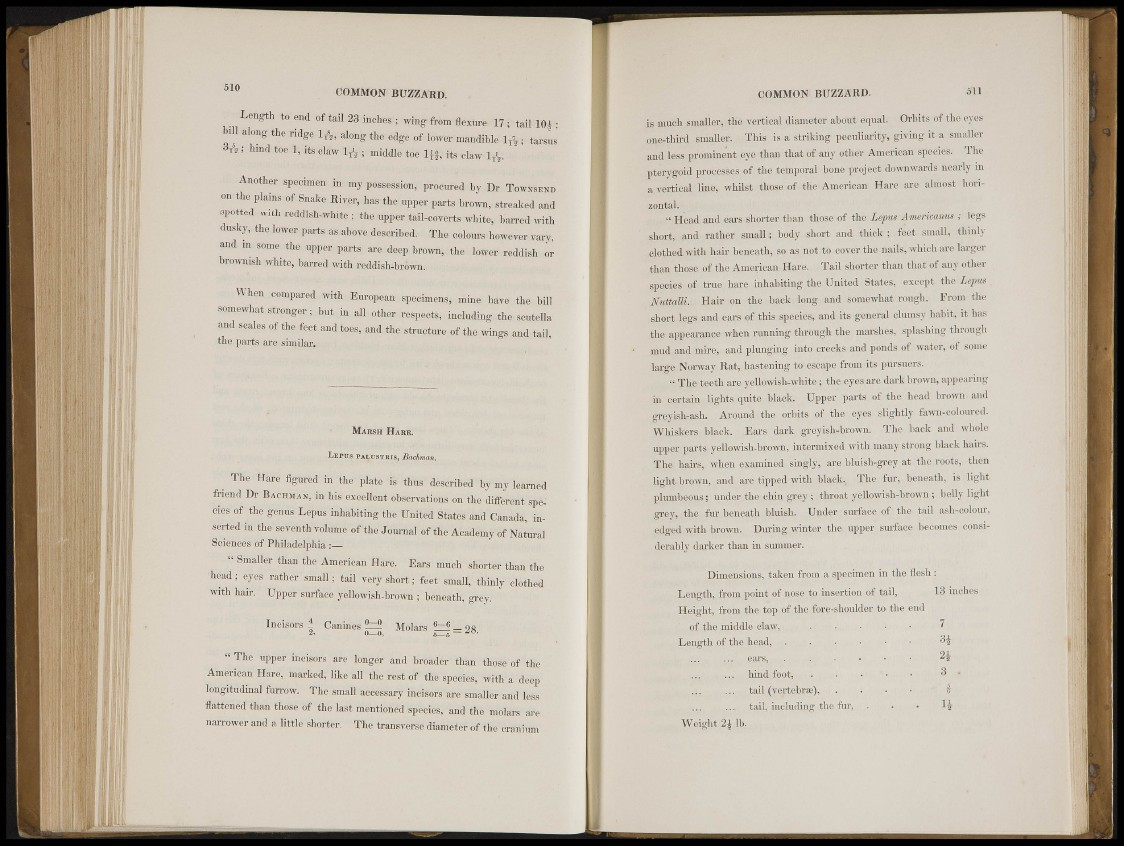
510 COMMON BIT/ZA KI).
• J-ength to ,.,,,1 (if 1 ail 23 inches:; wing from flexure.-1.7 tail 10j •
bill along the ridge l A i along th& edge of lower mandible l ^ r
^ « M t ^ e ^ l B ^ ^ middle too . l ^ i ite-claw.^!.;,.
•Another specimen in^possession,- procured. by Dr T ow^ n
on the plains oflSnaie Riyer, has theiupper parts W ™ , .treated and
spotted with-redfch-white, the upper toil-cdyerts .white, barred with
t h o lmv , T P ^ 8 <*><>Te described. The -colour, however varV,
and in some the upper parts are deep brown, the lower) reddish or
brown,sh white, ban-,..! with reddish-brown. -
Wla«fcpared,wiA.J3uropean./specin«®, mine have the' M
somewhat stronger, but m gvof ter tresp^Simcludmg^soutena
flefe of the feet a u t o e s , aad t h e ^ u c t u r e o i j f c wings and tail,
the parts are similar.
MARSH HARE.
I . K F t ' s I'ALlrsTBit, /Itchman.
The I fare fU»»& in tla' pMfc'it thus described by my lcuned
friend Dr HACHMA.V, in l,is ex'coliiint observations on the dillW/t speJ
«eg of the genug Lepus inhabi t% the ttuted States and Canada, inserted
in t h e f ^ t n t h v o W of'the Journal of t i e A S a » y of Nattail
Sciences of Philadelphia
" Smaller than the Ameri'can Hare. Ears mfeh shSrtet than the
4 e a d , fye's rather small; tail 'vefjr short j'ffefet small', thinly clothed
with h&fr. Upper suffice yellowish-brovra; beneath, g r f y '
Incisors | 'Caninft'^Bi Molars iL_®~ os
" T h e uppfer inci te'fe-' longeSr and broMer than 'thate of the
H H B marl£ed, I f e t t aiereSt of H J with'ji'deep
longitudinal furrow. The 'small 'akcMtity 'ihcisors are smaller and legs
Htefened than those of the last montio/tol'species. and the molars are
narrower anff a little shorter: The traii^-iiS diameter of flii^rSm,,,,,
COMMON BUZZARD.
is much smaller.; the vertical diameter about equal. Orbits of the eyes
„„..-third smaller! This is.a striking peculiarity, giving it a smaller
and less prominent, eve-'than that of any other American species. The
pterygoid processes of the temporal bono project downwards nearly in
a vertical line, whilst those of the American Hare are almost horizontal:^../
•
Head and ears shorter, than those of the. Upm Airoericumu ; legs
short, #ndi rather smaH.;. body short and thick ; foot small, thinly
clothed with hair beneath, as not to cover the nails, which are larger
than those of the American;Hare. Tail shorter than that of any other
species of ttfue hare inhabiting tho United suites, eseept the Lepus
MtMatti. Hair, on the back -long and somewhat rough. From the
short legs- and ears of this species, and its general clumsy habit, it has
tho appearance -when running through the- marshes, splashing through
¡mud and mire, and plunging into creeks and ponds of water, of some
large Norway Rat, hastening to escape from its pursuers.
" The teeth are yellowish-white ; the: eyes are dark brown, appearing
in certain lights ¡piite black, tipper parts of the head brown-and
greyisfcash. Arotiud X ; orbits of the eyes slightly fawn-coloured.
Whiskers black. ; .HOTS dark grcvish-brown. The back and whole
upper parts yellowish-brown, intermixed with many strong black hairs.
The hairs, when examined singly, are bluish-grey at the roots, then
light brown, and are tipped w ith black.. The fur, beneath, is. light
plumbeous S under the chin grey ;; throat yellowish-brown ; belly light
grey,«tofe^ I'm- beneath bluish. Under surface of the tail ash-colour,
« â p f l .with brown. During winter the Upper surface- becomes considerably
darker than in summer.
Dimensions, taken from a specimen in the flesh :
Length, from point ot' nose t.o insertion of tail, 13 inches
Height, from the top of the. fore-shoulder to the end
of.the middle/claw, . "
jLe^grth.pf the head, 8J
-1 y. - . . . . . '¿k
I hind foot, . . • • « *
tor:^ Liii*:".''.^.toi-I. ertel mac), . • • i s
... taiiiiiciuding the fur, . . . 1-J
Weight 2J lb.